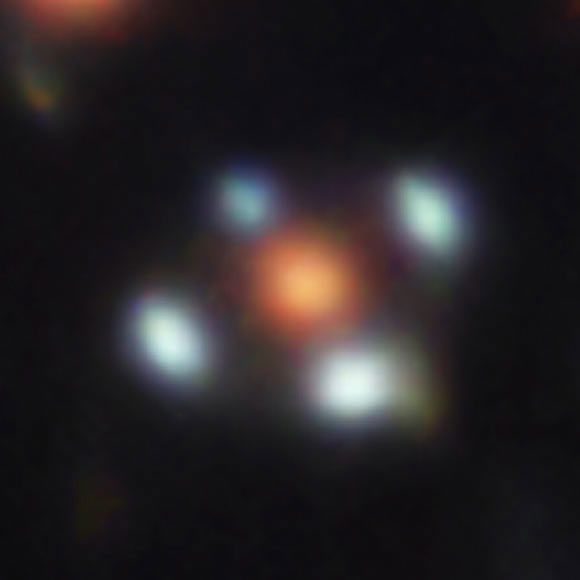The Very Large Telescope of the European Southern Observatory (ESO) has captured a rare cluster of cosmic objects, consisting of a galaxy and four “cosmic ghosts” created by the warping of space-time.
This peculiar cluster features a colossal elliptical galaxy, which appears in a reddish-orange hue through ESO’s lens, along with four other objects symmetrically arranged around it, forming a massive cross shape.
According to Sci News, scientists have recently named it DESI-253.2534+26.8843 and identified it as an extremely rare “Einstein Cross”, formed from two phenomena known as “redshift” and “gravitational lensing”, as described by the renowned scientist Albert Einstein.

“Einstein Cross” recently discovered – (Photo: ESO).
The red elliptical galaxy at the center of the cross is colored due to the phenomenon of redshift. According to a team of scientists led by astronomer Aleksandar Cikota from the Gemini Observatory, the light from this galaxy began its journey towards Earth when the galaxy was only 20% of its current age.
This means that the image we see belongs to over 11 billion years ago. However, due to the expansion of the universe, it is no longer 11 billion light-years away but has “run” even farther away, causing the apparent light to shift towards the red spectrum, resulting in its unusual coloration.
Meanwhile, the gravitational lensing phenomenon has duplicated this galaxy into four ghostly images, which form the arms of the cross.
In astronomy, gravitational lensing refers to massive objects that are closer to Earth, situated in the space between Earth and the object being observed.
These massive “intervening” objects have a tremendous gravitational field that warps space and time, altering the light from the object being observed: it can make it appear brighter, larger, or create multiple “ghosts” that deceive the observer’s eye.
This discovery is not just an intriguing image. According to a publication in the Astrophysical Journal, seeing an ancient object with five distinct, relatively clear images is a unique opportunity to learn about the early universe.
In this preliminary publication, the authors state that DESI-253.2534+26.8843 is a galaxy that is actively forming stars, indicating a world filled with numerous possibilities for exploration.





















































